Past Projects
Daniel K. Inouye Solar Telescope 4.2m off-axis primary mirror
The DKIST is an off-axis parabolic mirror with extreme smoothness on an extremely high aspheric surface. The project was started on 7/1/2014 and was completed on 10/27/2015. This schedule included Grinding, Stressed Lap Polishing, and Passive Lap Polishing in approximately 13 months from generated surface to finished product.
Some specifications include:
Diameter: 4.24 m (13.78 ft)
Clear Aperture: 4 m (13 ft)
Thickness: 75 mm (2.925 in)
Radius of Curvature: 16 m (52 ft)
Virtual Parent Diameter: ~12 m (~39 ft)
Material: Zerodur
The BRDF was measured to less than 1.0 sr-1 at 0.002 radians from the specular direction.
The Irregularity was measured to be 4.4 nm RMS over a 120 mm diameter.
The Surface Figure was measured to be 16.9 nm RMS over a 4 meter diameter.
The Surface Finish was measured to be 1.0 nm RMS over 2×2 mm.
[cycloneslider id=”dkist”]
Check out more information here:
Fabrication and Testing of 4.2m Off-Axis Aspheric Primary Mirror of Daniel K. Inouye Solar Telescope
National Solar Observatory DKIST Frequently Asked Questions
Osiris-Rex PolyCam
The Origins, Spectral Interpretation, Resource Identification, Security, Regolith Explorer (OSIRIS-REx) is an NASA asteroid study and sample return mission. One of the most important assets is a trio of cameras called the OSIRIS-REx Camera Suite (OCAMS), developed at the University of Arizona. PolyCam, an 8-inch telescope, acquires images with increasingly higher resolution as the spacecraft approaches the asteroid. PolyCam was built in the Large Optics Shop Clean Room facility.
PolyCam is the largest camera of the OCAMS suite. It is a 20.3-centimeter (8-inch) wide telescope with a 63.5-centimeter (25-inch) focal length. It has a resolution of about one-sixth of an arc minute. Its field of view is just less than 1°. It is used for several critical tasks: to acquire the asteroid while it is still a point of light against the background stars, to identify and exclude dangerous areas on the asteroid’s surface by spotting and mapping large boulders and rocks, and to characterize a dozen prospective sample sites in detail. PolyCam has a focus mechanism that converts this telescope into a microscope – allowing our scout to scrutinize the tiniest rocks and pebbles on the asteroid to ensure that they are small enough to fit into the sample head.
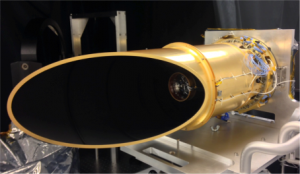
Check out more information here:
ULA Atlas V rocket launches OSIRIS-REx payload
Hobby-Eberly Telescope Wide Field Spherical Aberration Corrector
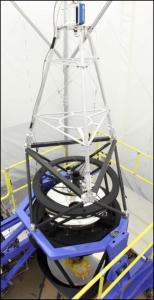
The Wide Field Corrector for the Hobby-Eberly Telescope is a four-mirror optical system which corrects aberrations from the 10-m segmented spherical primary mirror. This system uses 1-m class highly aspheric mirrors to meet the performance requirements. Novel alignment methods were developed in order to test this highly advanced optical system. The optical system was designed, assembled, aligned, and tested in the Large Optics Shop.
Check out more information here:
Alignment of 4-mirror Wide Field Corrector for the Hobby-Eberly Telescope
Large Test Flat Calibration System for industry
All project specifications classified.
Race track mirror fabrication for government
All project specifications classified.
1.4m off-axis convex mirror fabrication for industry
All project specifications classified.
Giant Magellan Telescope 0.8m Fold Sphere
The GMT M2 fold sphere was completed in 2009 and was used as a test optic to complete the GMT 8.4 meter off-axis segment in 2012. It was used in the principal optical test with its full aperture in interferometry. The OEFF team polished an extremely smooth surface to within 3.3 nm over 740 mm.
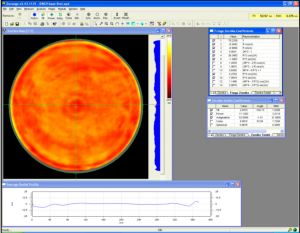
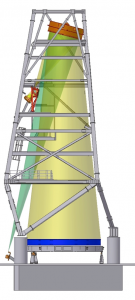
Discovery Channel Telescope
The large optics shop polished the primary mirror for the Discovery Channel Telescope (DCT) which is to be housed at Lowell Observatory. The F/1.9 mirror blank was approximately 4.3 meters. The DCT specified an aperture to be 4.2 meter and the OEFF UA team flattened the edge all the way enabling the DCT to use its full 4.3 meter full aperture. The surface figure was measured to be less than 15.5 nm RMS with zero tolerance to the edge margin.
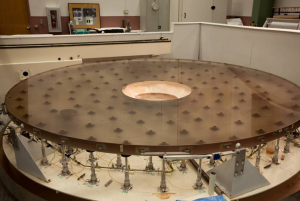
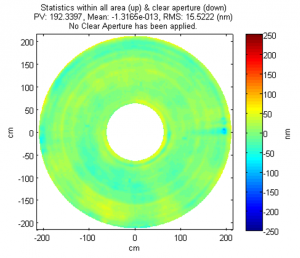
Offener Scanning System for industry
All project specifications classified.
Arizona Imaging Spectrometer (Starlight)
A 16″ R-C telescope for a space shuttle experiment–This novel telescope’s optics and structure are made entirely of a metal matrix composite comprised of aluminum and silicon carbide. This design provides an athermalized telescope which is extremely rugged and achieves diffraction limited performance over a 1 degree field.
Gravity Probe B Facetted Quartz Block
A two facetted quartz blocks for the Gravity Probe B spaceborne experiment–These blocks have tenth wave requirements on surface figure and one arcsecond perpendicularity tolerances between facets in two planes.
Far Infrared Space Telescope Technology Demonstrator Mold
A 2 meter diameter convex F/1 sphere for the FIRST program–This convex sphere will be used as a mold for demonstrating replicating technology for graphite-composite based optics.
James Webb Space Telescope Technology Demonstrator
An ultra-lightweight 2 meter diameter, 2 mm thick demonstrator mirror for the JWSB program–The University of Arizona has developed a process to fabricate thin shells which can be actively controlled for figure correction. The shell will be attached to actuators which will be mounted on a carbon fiber support structure.
DCATT Primary Mirror
A 1 meter diameter aluminum mirror for DCATT (Developmental Cryogenic Active Telescope Testbed). The goal of the testbed is to represent in hardware an optical system that incorporates all of the functional elements envisioned in the NGST active optical system, and to investigate the viability and efficiency of candidate wavefront sensing and wavefront control techniques and algorithms. Arizona Daily Star story
Hughes 1.5 Meter Reference Sphere
A 1.5 meter reference sphere with a 10 meter radius of curvature. This mirror will be used in a cryo chamber as part of a testbed for sensor packages.
Greenbank Telescope Retroreflector
Designed and Fabricated a retroreflector design which achieves an acceptance angle of 120º compared to 24º for a typical cornercube reflector. 18 retroreflectors will be positioned on the perimeter of the Greenbank Telescope for measuring deflections induced by wind and gravity loading.
EUV Imager Mirrors
Nine F/0.5 primary mirrors to be used in a spaceborne EUV Imager. These mirrors were figured to an accuracy of better than an eighth wave with a surface roughness of better than three Angstroms rms.
SLOAN Digital Sky Survey 2.5 Meter Primary
A hyperbolic F/2.2 2.5 meter primary mirror for the SLOAN digital sky survey. This telescope will be used to perform a digital sky survey in support of cosmology studies. This article shows a detailed description of the implemented telescope complete with optical prescription, image analysis, and photographs.
Multiple Mirror Telescope Primary and Secondary Mirrors for the Smithsonian Institute and Stewart Observatory
Fabricated seven 1.8 meter diameter primary mirrors and six secondary mirrors. This telescope was based on new technology which utilized six primary mirror segments to effectively act as one monolithic mirror.
Allegheny Observatory 30″ Objective
Fabricated a 30″ doublet objective which was achromatized for the red. This telescope is used to search for planetary systems outside our solar system.
United States Naval Observatory Astrographic Lens System
Fabricated five lenses ranging in size from 8.5″ to 10.5″ which comprised the Astrographic Lens System. This system is used to take distortion free photographs of the sky in order to accurately track the movement of stars. This is arguably the best lens of its kind in the world.
Developmental Ultra-lightweight Metal Foam Telescopes for the United States Department of Defense
Fabricated several developmental telescopes which used metal foam primary mirrors. The mirror sizes ranged from 8″ to 16″ in diameter.
Jet Propulsion Laboratory 1.5 Meter Off-Axis Parabola
Developed a new technology for fabricating large off-axis optics. Fabricated a 1.5 meter optic for JPL and performed fabrication research on several other optics involved in the SDI program.
Optical System for the Descent Imager/Spectral Radiometer
Fabricated the optics for a spaceborne optical system which is used for geological studies. This work was performed by the following organizations: Lunar and Planetary Laboratory, Jet Propulsion Laboratory, United States Geological Survey, Dept de Recherche Spatiale (France), Max Planck Institut fur Aeronomie (Germany), and Technesche Universitat Braunschweig (Germany).
NASA Fabrication Experiments
Developed and utilized fabrication methods to produce large antenna reflector mold segments used for replicating optical surfaces. Fabricated several convex off-axis paraboloid optics for the Solar Telescope Project.
Bok 2.3 Meter Telescope Primary mirror
Fabricated a 2.3 meter primary for a telescope located at Kitt Peak National Observatory and operated by Steward Observatory.
2 Meter Aperture Collimator
Fabricated the optics for a three mirror collimator which produces a 2 meter diameter beam for the United States Army Missile Command.
High Gravity Environment Infrared Source Collimators
Fabricated several two element collimator systems for the United States Air Force which produced 6″ diameter unobscured beams and can survive a 10G load.
Test Optics for the 6.5 Meter MMT Conversion Primary Mirror
Fabricated the null lens optical elements used to test the MMT conversion 6.5 meter primary mirror.

